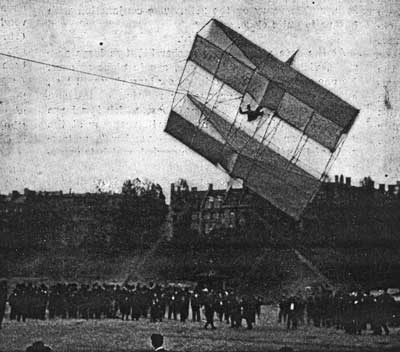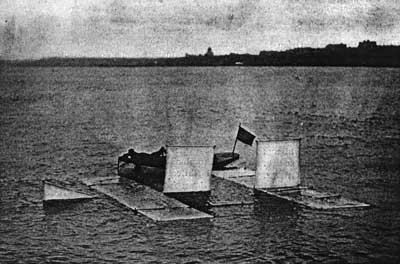

Many of the readers of the SCIENTIFIC AMERICAN are probably more or less familiar with the numerous aeronautic experiments of Israel Ludlow, of New York City, whose investigations in the problems of aerial flight have been large in number, sometimes apparently successful, and frequently spectacular. The latest of these occurred on Sunday, October 22, when the aeroplane carrying Charles K. Hamilton, a professional aeronaut, was successfully launched into the air from the east bank of the Hudson River, and after a flight of some minutes' duration, settled gradually into the water near midstream. Mr. Ludlow claims to be entirely satisfied with the experiment, as this, as well as the previous ascensions, was merely a test to determine the capability of the machine to glide to earth from a height to which it had been raised in a manner similar to that of flying a kite. In the former flights, the aeroplane was launched into the air by means of an automobile and a long rope, but as the experiments, in consequence of space limitations, were necessarily short, the flights were rather unsatisfactory, both to the inventor and to the large crowd of inquisitive spectators assembled at the river front and 79th Street, where an open dock space offers the necessary facilities. The experiment of the 22d was intended thoroughly to test the flying, or more properly the gliding properties of the machine, and for this purpose the motive power at the end of the rope, or "kite string," was a powerful tugboat, an arrangement permitting the use as a course of the unbroken sweep above the river.

The Beginning of the
Flight, Just as the Pull Began to Affect the Aeroplane
The aeroplane was placed at the bank side of the dock, and attached to the towing-bits of the tug by means of half-inch Manila hemp rope. After a number of unsuccessful starts--the slack not being completely taken up before the drag acted on the machine-- the aeroplane was at length flung into the air in the teeth of a strong wind, and rose almost perpendicularly under the combined influence of this and of the powerful tractive effort of the vessel. Until a height of approximately 500 feet was attained the rise was rather erratic, for as the puffs of wind struck the machine it would plunge violently from side to side. Hamilton, however, with great coolness, managed to keep the giant white-winged kite on an even keel by shifting his weight from one point to another as the occasion required, and when more than 600 feet of rope had been let out from the tugboat, the machine settled down and followed steadily in the wake of the vessel. The above-mentioned height of 500 feet is probably a fair estimate, as the aeroplane was almost vertically over the boat, with 600 feet of rope let out. Shortly after this a ferryboat crossing the course of the tug necessitated the turning out of the latter at right angles, with consequent slackening of the rope drawing the aeroplane. Before this slack could again be taken up, the aeroplane, gliding forward and downward without apparent lateral movement, gradually and steadily in the face of the wind, had settled to the surface of the river, whence Hamilton was rescued by a launch, slightly damp but as cheerful and unshaken as ever.

Under Way; The Aeronaut
Striving to Balance the Plunging Kite-like Structure.
This test appears to substantiate other experiments tending to prove that an aeroplane of this type can be caused to rise, and can be kept in the air as long as the tension on the rope connecting it with the motive power be maintained. Whether or not sufficient power through a prime mover and propellers can be carried by the aeroplane itself to keep it afloat in the air, is still an open question. There can be little doubt, however, that until engines are constructed that are far more powerful and much lighter in weight than those available today, it is impossible to launch an aeroplane flying machine by means of its own power. Mr. Ludlow says that judging from the successful gliding tests just completed, he feels assured that an engine can be installed upon the machine sufficiently powerful to keep it afloat after it has been launched by other means It would be easy to guide the aeroplane as the mere shifting of the center of gravity-accomplished by the movement of the operators body to one side or the other causes a consequent swerve in a corresponding direction.

The aeroplane used in the latest test differs little from that employed in the more recent of the former experiments, and its structure is clearly shown in the accompanying illustrations. The entire body consists of elements or unit cubes five feet on a side. The frame, which is constructed of bamboo and piano wire, consists of twenty of these cubes, being five cubes broad and four long, while the height is that of one cube edge, five feet. There are two sets of supporting surfaces, one forward of the other, with an open space between. The operator's position is located in this open space. Each set consists of an upper and lower horizontal surface, with a middle surface between these, fixed at a diedral angle, resembling the position of a soaring bird's outstretched wings. The inventor declares that the air flowing through the triangular opening between the upper and middle surfaces gives direction and steadiness to the aeroplane, very much as do the air currents that pass under and between the feathers of the wings of a bird in flight. The ratio of square feet of supporting surface to pounds of combined weight of aeroplane and aeronaut is about 2 1/2 to 1, a value nearly equal to the average proportions of many soaring birds. The movement of the aeronaut in the aeroplane, with intent to guide it, resembles in principle the action, reversed, however, of the air bladder which every fish possesses. One of the best features is the form of truss bracing, by which it is possible to get 680 square feet of supporting surface to 125 pounds of weight. This is accomplished by running taut piano wires from each corner of the unit cubes and of the squares forming the surfaces of these cubes, to a corner diagonally opposite, and the rigidity and strength of the frame in consequence of this construction is astonishing. The diedral angle of the middle surfaces, in the event of a lateral tipping, makes the surface on the side which is down approach the horizontal, while the other side is inclined upward, and thus corrects the equilibrium, as greater air pressure is exerted on the side that is flat. The value of the dorsal fins has not quite yet been determined, but it is believed that they, as well as the rudder, tend to steady the aeroplane while in the air. The open space between the forward and rear sets of surfaces tends to decrease the effect of gusts of wind sweeping suddenly upon the machine, as these are prevented from traveling the full length of the aeroplane, the sticks of bamboo crossing this space acting as a fulcrum against which undue air currents must press.

After the Ascent;
Rescuing the Aeronaut from the Floating Machine.
Originally appeared in Scientific American, 93, November 4, 1905, p. 356.
sbck, htgb